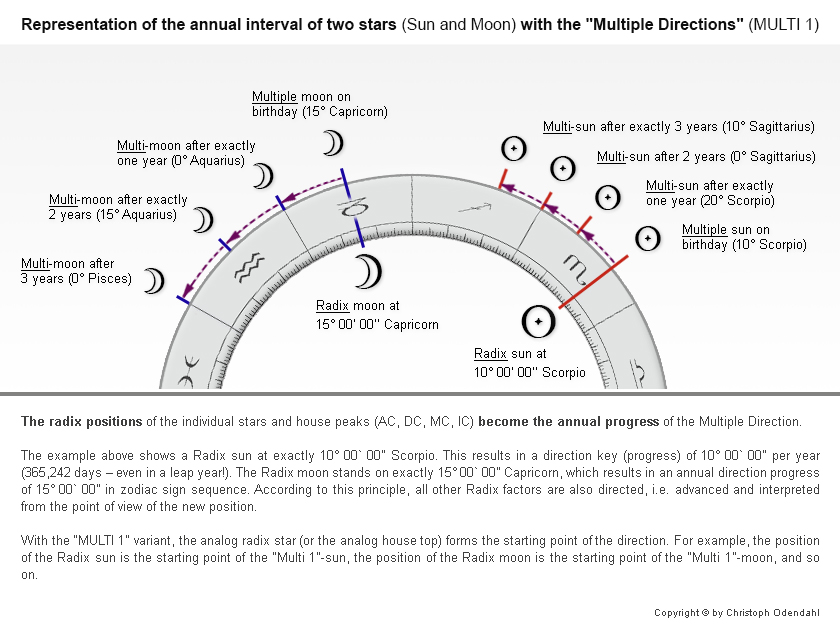Basic information & Calculation
The direction method presented here - "Multiple directions" - claims to surpass previous systems in terms of expressiveness and accuracy. This new method was published for the first time in comparison to the harmonics in the astrological journal 'Meridian' in September 1993. A new presentation by Christoph Odendahl took place there in January 2008. The new management system - called "Multis" for short - was designed by Stephan A. Lehrieder developed in a 5-year intensive course between 1964-1969, which was mainly concerned with being able to recognize numbers (lottery numbers) in the horoscope.
Already Pythagoras claimed
"... that every number is in itself a living principle that has a meaningful soul quality that reveals a fundamental law of life".
The knowledge gained could then also be applied to life events of people or project start-ups, stock exchanges, earthquakes, daily events and others. be transmitted. Unfortunately, the sciences have reduced the numbers to nameless quantities only.
The multinationals assume that the position of a natal star is not only effective in degrees and minutes, but that the last exact arc second has an individual relationship with the horoscope owner. The distance of the position of a natal star from the zero point of the related zodiac sign is not an arbitrary or even "accidental" one. With overwhelming clarity, events and situations related to the natal charts could be confirmed and related via constellations that are only possible with multinationals.
What are Multiple directions?
First of all, the concept of direction must be dealt with. Direction is an astrological collective term for time-dependently advanced stars according to different direction keys, such for example 1 degree = 1 year. This means that each star is advanced by 1 degree per year of life and is to be assessed from the new position.
In the astrological journal MERIDIAN from May 1993, Werner Popp first drew attention to the new direction method of the multiple directions, which was discovered by Stephan A. Lehrieder, compared to the harmonics. As a result, many software authors have integrated this new system, unfortunately often only in 2 variants, which considerably limits the use of this management method. At least Astroplus from Astrocontact in Linz/Austria offers all 5 multi-variants.
The Multiple directions - or multis for short - is a new astrological evaluation system, which is an essential enrichment of astrological studies due to the variety of the fanned out planets. In the long term, this system will be the starting point for the basis of scientific astrological research and help to convert previous aversions against astrology. Just the convincing representation of political events in the national horoscopes, temporal catastrophes such as earthquakes, accidents in nuclear power plants or the astrological problems of cloned living beings, but also economic events such as B. dollar fluctuations, share prices, etc. force in my opinion to give up the negative attitude towards astrology. The outcome of the federal election in favor of Federal Chancellor Helmut Kohl was published in MERIDIAN 3/94 and predicted in writing as early as February 1994, although according to the survey he could only expect 27% of the votes. (His opponent had 47%).
Calculation
In the 'Multis', the natal position of the stars, the AC, MC, the top of a house or another sensitive point becomes the annual interval and thus the annual progress. To do this, it is necessary to convert the radix position into a decimal fraction, which is multiplied by the event age. The result can then be added up in various ways either to the starting position or to the zero point of a controlled zodiac sign or to a sensitive point. This creates new, interpretable planetary images that often show the event with overwhelming clarity. All the calculated results can also be added up to just one planet. B. reveals more meaningful in his domination. Another possibility is to record the distance of a star from 0° Aries to the natal position, which is also to be multiplied by the event age and added to the natal position.
Representation of the annual interval between two stars (Sun and Moon) with the 'Multiple directions' (MULTI 1)
The following example graphic shows a radix sun at exactly 10°00'00'' Scorpio. This results in a management key of & nbsp; 10°00'00'' per year (365.242 days). The natal moon is at exactly 15°00'00'' Capricorn, which results in an annual directional advance of 15°00'00'' in the zodiac sequence. According to this scheme, all natal factors are directed and evaluated / interpreted from the new position.


